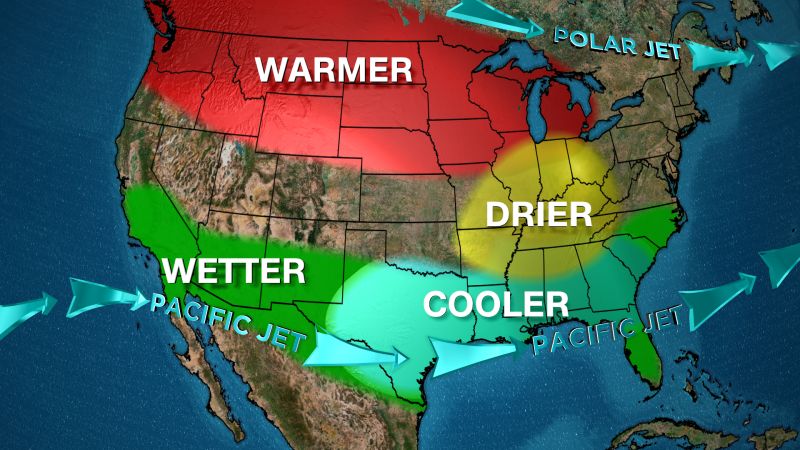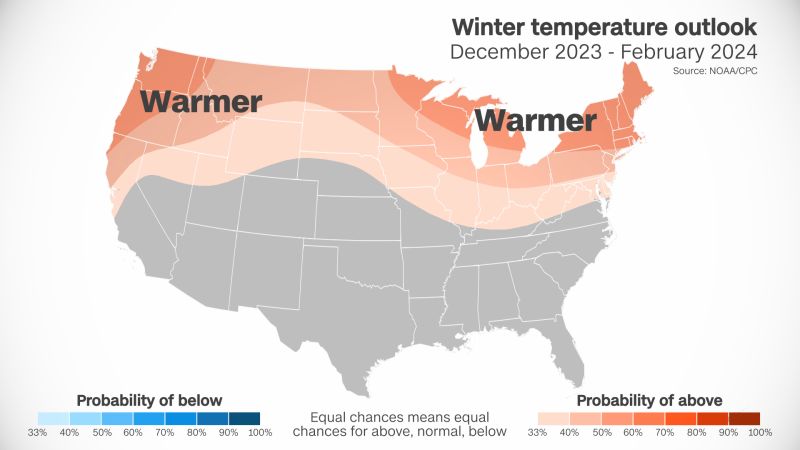
A Chilling Forecast: Brace Yourself for the Impact of El Niño on the United States

Get ready for a unique winter ahead as El Niño takes the stage Brace yourself for a season that promises to break away from the norm, bringing unexpected weather patterns and surprises Don't miss out on what could be an unforgettable winter experience
Winter is on the horizon and with the arrival of El Niño, this year's winter could be unlike any we have experienced in recent times. Brace yourself for the significant influence this phenomenon will have on our weather during the coldest months.
The El Niño Southern Oscillation, a phenomenon that monitors changes in water temperature in the equatorial Pacific Ocean, has three phases, with El Niño being one of them. This phase occurs when ocean temperatures remain warmer than usual for an extended period and can significantly impact global weather patterns. The current El Niño started in June and is predicted by NOAAs Climate Prediction Center to be a strong one lasting until early next spring.
La Niña, the cooler counterpart of El Niño, had a significant impact on the last three winters in the United States. It caused dry conditions in the South while bringing much-needed snow to certain areas in the West.
The Climate Prediction Center's initial forecasts for the upcoming winter show similar patterns to those typically associated with El Niño, suggesting that there may be changes ahead.
What could this winter look like?
No two El Niño winters are the same, but many have temperature and precipitation trends in common.
Average conditions during an El Niño winter across the continental US.
The position of the jet stream is a significant factor, as it often shifts south during an El Niño winter. This shift results in wetter and cooler weather in the South, while the North experiences drier and warmer conditions, as stated by NOAA.
Due to the jet stream being a pathway for storms, they can pass through the South more frequently during an El Niño winter. This increased storm activity leads to higher levels of precipitation, typically occurring from the southern Plains to the Southeast. This could be particularly beneficial for states such as Texas, Louisiana, and Mississippi, which have been suffering from drought conditions.
A wetter southern tier and a drier northern tier in an outlook for this winter from the Climate Prediction Center have all the fingerprints of an El Niño winter.
The cooler temperatures and increased precipitation can raise the likelihood of wintry precipitation such as freezing rain, sleet, and snow in the Southern regions.
In the Northern areas, including the Pacific Northwest, Rockies, Plains, and Midwest, El Niño generally results in a milder winter. However, occasional storms may still develop and bring periods of extreme cold or heavy snowfall, although they occur less frequently.
This would be problematic for areas in the Midwest that are already experiencing severe and unprecedented drought conditions, as well as for the snowpack in the Pacific Northwest - a crucial water source for the region.
The northern tier of the US has the highest likelihood of experiencing above normal temperatures this winter, according to the Climate Prediction Center's outlook. This pattern aligns with climatology. California, the Southwest, and the Northeast tend to have less predictable El Niño winter patterns.
The frequency and intensity of storms and precipitation in California and parts of the Southwest may be influenced by the strength of the El Niño. A stronger El Niño could result in more storms, bringing rain at lower elevations and snow at higher elevations. Conversely, a weaker El Niño could leave the Southwest with limited rainfall.
The Northeast experiences less predictable weather patterns during an El Niño winter. It may have milder conditions similar to other northern regions, but it is also vulnerable to powerful coastal storms along the Atlantic Coast.
Utility workers tend to power lines weighed down by snow and ice from a winter storm in Raleigh, North Carolina, on Jan. 23, 2016.
Harry Lynch/Raleigh News & Observer/Tribune News Service/Getty Images
Looking back at recent El Niño winters can also help visualize what the upcoming winter may have in store:
During the 2018-2019 season, a weak El Niño resulted in a series of notable storms. In December, a storm caused the spread of snow and ice from Texas to the Carolinas. Additionally, it was the wettest winter ever recorded for the US mainland, and most of the East experienced higher than average temperatures, as stated by NOAA.
In contrast, the 2015-2016 winter witnessed a very strong El Niño, leading to the warmest winter ever recorded in the US mainland, according to NOAA. Surprisingly, the warm weather didn't deter the occurrence of severe snowstorms, including a deadly blizzard that paralyzed travel along the East Coast.
The winter of 2009-2010 was the final one to have an El Niño of comparable forecast intensity to that of this year. Data from NOAA indicates that it was notably chilly in the southern and central regions of the US, while the East Coast experienced excessive rainfall and heavy snowfall. This particular season gained notoriety due to a series of consecutive blizzards that struck the Northeast in quick succession.











